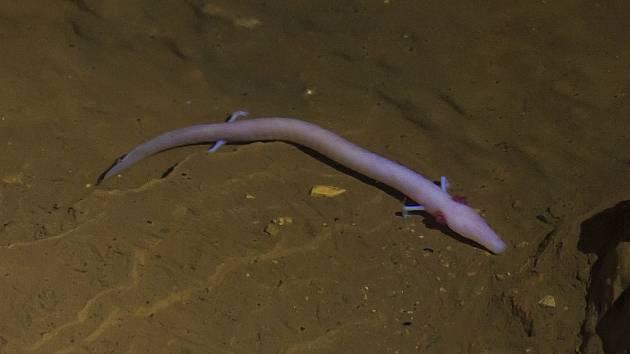The world's strangest creatures. Baby dragons live in a Slovenian cave<
Today it is already clear that they are cave salamanders, but they are still one of the most special creatures on the planet. The Slovenian Cave is the only place in the world where they can be seen. Even the American channel CNN has already noticed the unique thing.
A breakthrough find. A retired doctor was bored during the lockdown, he discovered a new dinosaurThe little dragons from the Postojna Cave look really unusual. They live underwater, have white skin, an elongated body, a long tail and four legs. "After hearing many strange stories, scientists also became interested in them. In the 18th century, biologists competed with each other and literally fought over who would introduce a new animal species from the Postojna Cave. Giovanni Antonio Scopoli was the first to obtain a living specimen of this unusual creature. In 1768, the "little dragons" got their scientific description and Latin name: Proteus Anguinus, i.e. cave macarat," according to the official website of the Postojna Cave.
For the leg to grow...
Scientific research on the creatures has only just begun with this and has not stopped yet. It continues even these days. There is even a laboratory in the cave where scientists study animals - they have ten specimens at their disposal. "Experts are examining their DNA. The drake genome is sixteen times longer than the human genome, and much more complicated. We still have a lot of empty seats. Imagine a six-hundred-page book in which all the words are encoded, and we have to reconstruct its story," biologist Primož Gnezda, who has been researching cave macarates for years, outlined for CNN.
Creature research can have great implications for humans as well. "Their regenerative capacity is amazing. If they lose a limb, it grows back. The aim of the research is to find out the mechanism behind it. It does not mean that we can then arrange for a person to regrow an arm or a leg, but perhaps that scientists in the laboratory can make a new limb from the person's cells, and then attach it to the recipient. Although that is of course a very, very distant future," said Gnezda.
Princesses on the menu?
Not only the ability to grow limbs is unique to cave dragons. Their whole life inspires admiration. Macarats can live up to a hundred years, and are able to function without food for long periods. "They can do it for seven years. The first two to three years tend to be completely problem-free. They then begin to lose weight, stop moving, and simply wait for their prey to pass by. After seven years without food, some may die, but some will survive, it depends on the individual metabolism," summed up Postojna Cave marketing director Mateja Rosa.
Of course, cave dragons don't eat princesses. The basis of their food is worms. “Worms form a small ball in the water, dragons fly in and swallow it like a vacuum cleaner. Sometimes they eat so greedily that then we see worms crawling out of their gills together with the water," outlined Gnezda.

According to the biologist, it is also interesting about these creatures that it is impossible to tell from their DNA whether they are male or female. And their looks don't help either. Scientists are now trying to determine the gender from blood, but it is not yet certain whether this method will work.
An extraordinary find. Archaeologists discovered the skeleton of a man in England, he was crucifiedNevertheless, experts have already noticed that the Macaratians also have a mating ritual. Specifically, they dance together. "When the female is ready, she swims up to the male. When he smells her, he starts swimming in front of her. She follows him and they make several circles together. At one point, the male releases a packet of seed to the bottom. The female picks it up and stores it in her body. When the egg comes out of it, it will fertilize itself," Gnezda described reproduction.
What are tv shows that all comedy writers should watch?
— Tasha Henderson Sun Jul 25 02:47:03 +0000 2021
The mother's eggs usually stick to rocks to protect them from predators. Even so, most of the young will die during development. When researchers observed the development of the eggs of one particular female in 2016, they noticed that the young were born after four months.
Macarats measure 25 to 30 centimeters, and they need an environment colder than 15 degrees above zero to live. "In the water, they move like snakes by twisting their bodies with the help of their legs. They breathe with external gills and only rudimentary lungs. Although adult macarats have no eyes, thanks to their skin receptors they can "see" practically everything," the cave's official website notes.
A place full of mysteries and surprises
As if it were not enough that the Slovenian cave is the "home" of little dragons, it also offers a lot of other unique things. These make it one of the most visited attractions in the country, even though the coronavirus pandemic took hold here too and the number of visitors has decreased in the past two years. "People have been living in the cave for centuries, the wall paintings in it date back to 1213. It became a popular tourist spot after the last Holy Roman Emperor, Francis II, visited it in 1818. Habsburg," sums up the CNN server.
People take a train to the cave, because it is so huge that walking through it would be quite a feat. The train line is 24 kilometers long. "The train line ends at the massive Congress Hall, where the Milan Symphony Orchestra performed in 1930. The walking path then continues, for example, across the bridge that was built over the chasm by Russian prisoners during World War I," states CNN.
Visitors underground admire not only the huge domes with stalactite decoration. Many strange animals live in the cave. “It has cave crickets that eat their own limbs if they can't find any other food. Or maybe spiders that weave cocoons instead of webs," summarizes CNN.
The strangest animals in the world
Although the little dragons from Slovenia certainly aspire to the title of the strangest creature in the world, they have a lot of competition. The diary provides an overview of the strangest animals in the world.
- Star-nosed mole: a really unusual mole is found on the east coast of North America. His nose resembles a starfish. The mole uses its nasal protrusions to identify food, and it is probably thanks to it that it is the fastest in the world in this "discipline" - it can recognize whether what it has come across is edible after only 8 milliseconds
- Tailed Ksukol: this creature, which lives on the island of Madagascar, is nicknamed Aye-Aye by the local natives - it has the same name as their tribe. It is a semi-ape, but this primate has an ability like no other. It uses echolocation, which is typical for bats, for orientation. Aye-Aye is a solitary lazy creature. According to superstition, anyone he points his middle finger at will die, so the natives kill him as a symbol of bad luck, so his population is not large.
Bird infidelity. Faithful albatrosses began to change partners, scientists have an explanation- Huge skeleton: in the underwater world there is a fish whose appearance instills fear. The giant skeleton is a kind of "crossbreed" between a fish and an alligator. It is an ancient creature, its appearance has not changed since the Mesozoic Era. It can be found in the waters of the Mississippi River. When hunting for food, it uses the moment of surprise - it seems to be practically motionless in the water, and then at one moment it shoots at a tremendous speed. It can grow up to three meters in length.
- Glass frogs: in Central and South America there are creatures that can see under the skin. This is no exaggeration, the so-called glass frogs have translucent skin through which their insides can be seen. These are frogs of the tree frog species, an example of which is the translucent tree frog.
- Okapi: even among mammals there are many strange creatures. The appearance of the okapi, the closest relative of the giraffe, will surely surprise you - despite this relationship, they look partly like zebras, partly like deer. Okapi live by the Congo River in Africa.


 Tags:
Tags: Prev
Prev







